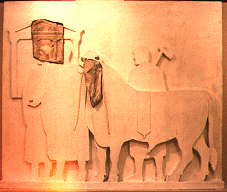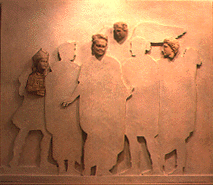

Proposed Reconstruction and Interpretation

The fragments are envisioned as part of a structure within the complex, a quadrilateral altar precinct resembling the Ara Pacis Augustae, the Altar of the Augustan Peace erected by Augustus in 13-9 BC. The facade of the precinct was enlivened by caryatids (anthropomorphic architectural supports). These male figures lean against palm trees whose foliage forms palm frond capitals that carry the entablature (see larger images). Caryatids symbolize submission to conquest and celebrate the power and glory of a Roman military victory. The palm trees allude specifically to the conquest of Judaea by Vespasian and Titus and function as symbols of the Flavian triumph.
The partial reconstruction comprises one half of the hypothetical precinct. The elevation is modeled on the system of proportions prescribed by Vitruvius, a Roman architect of the first century AD, and the dimensions of the Ara Pacis Augustae. The measurements and proportions of the Hartwig-Kelsey fragments conform to those of Vitruvian theory and Augustan architecture.
 |
 |
The fragments assigned to the historical relief panels have at least two subjects, one a religious rite and the other a state ceremony. The proposed arrangement of the figures is based upon comparisons with other official historical relief sculptures from the first two centuries of the Roman Empire.
The religious scene as reconstructed depicts a sacrificial procession that passes in front of the Temple of Quirinus. Aside from the priest and bull, the sacrificial victim, no other participants can be identified.
All the other heads (with the exception of the Kelsey Museum's soldier, cat. no. 10, whose dimensions are too large) are reconstructed as parts of a scene of adventus or reditus, a celebration in honor of the emperor Vespasian's victorious return to Rome. At the center of the composition, Vespasian is the tallest figure. The proper left side of the relief belongs to the Roman military sphere with one or more soldiers standing behind the emperor. On the right, Victory hovers above the ground at Vespasian's shoulder. The Genius of the Roman People and other unknown figures stand in front of her. The emperor wears the corona civica, an honorific oak wreath conferred on emperors as a symbol of their merit and clemency.
The adventus panel may have referred to Vespasian's restoration of peace in the Roman Empire after his victory in the Civil War of AD 68/69. By implication, it would also honor Domitian, who, according to ancient authors, decided to commemorate his family and celebrate the glory of the Flavian dynasty in a permanent monument, the Templum Gentis Flaviae.
Copyright ©1997, 2002 Ministero per i Beni Culturali e Ambientali, Soprintendenza Archeologica di Roma and the Kelsey Museum of Archaeology, University of Michigan. All rights reserved.
 |
 |
 |
 |
 |
 |
 |
 |
 |